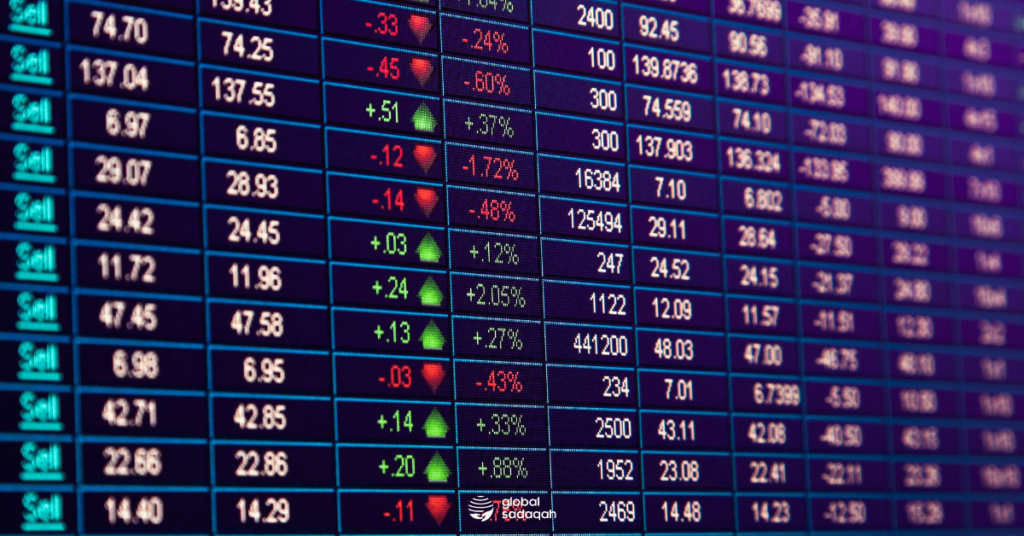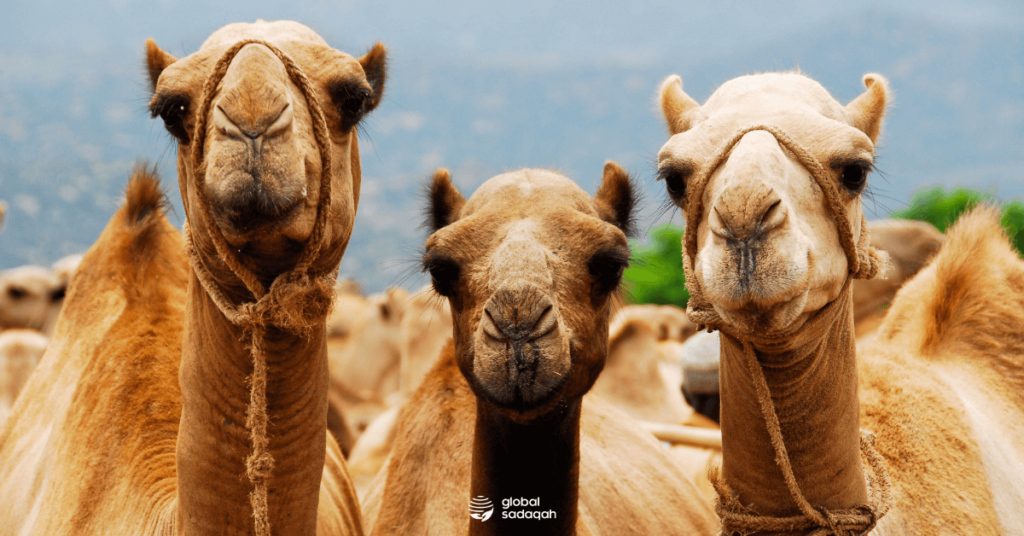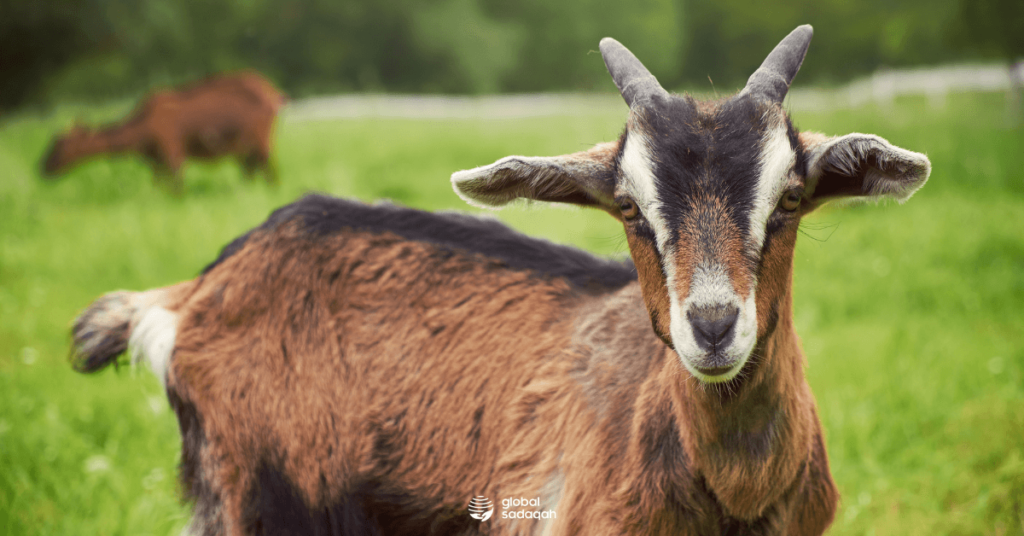This is the second edition of a two-part series on the types of zakat in Islam. Read on to find out what types of assets are considered zakatable. (Read the part 1 from here)
Previously, we’ve established that zakat is derived from the words purify and increase. Zakat is also an obligatory form of charity that Muslims must commit to every year, as one of the five pillars of Islam.
It’s because of these reasons that all Muslims need to learn how to perform the zakat correctly, which includes knowing how to assess zakat upon their own type of wealth and understanding the different types of zakat involved.
In this article, we will be taking a closer look at how zakat works on shares, animals, livestock, crops, minerals, treasures and cryptocurrencies.

Are you an active trader? Well the earnings from your shares are zakatable!
Zakat on shares – how does it work?
Another way to think of a share is to imagine it as a divided-up unit of the value of a company. A company’s shareholder is a partner in ownership of the company, according to the amount of shares he/she owns in the company.
There are two types of shareholders:
A) The passive investor
A person who has bought shares as a long term investment with no intention to trade or sell. However, they want to attain the dividends from this investment. This type of investor needs to consider their zakat calculation in relation to the relevant asset value of their investment and not the market value.
Passive investors should not pay zakat on their total portfolio. Rather, they should pay their zakat based on the cash receivables and the inventory that is held by the company.
The company that receives the investment, however, is obliged to pay zakat on their behalf —unfortunately, this is not the reality that we are seeing in today’s market.
In this scenario, the shareholder has to pay zakat on the shares and the dividend. The zakatable assets are identified and calculated based on the balance sheets of the company.
Alternatively, you could try the below steps:
- Calculate the market value of your holding. For example: 10,000 shares
- Take 40% of the value. In this case that would be: 4,000 shares
- Include this figure under assets in your calculation before applying 2.5% to all the assets.
B) The active investor
An active investor is a person who buys shares with the intention to trade for capital gain. Investors in this category should pay zakat on the market value of their shares on an annual basis.
Plus, their entire holding is subject to zakat—similar to a business owner buying and selling goods at higher prices. Any form of fluctuation in share price is irrelevant because what matters the most is the value of the shares on the day your zakat becomes due.
Other scenarios beyond what has been explained should be discussed with a zakat expert.
Important: When calculating zakat, dividend income should be factored in as part of the cash balance that a person identifies with. If the dividends are spent or reinvested then it does not need to be included in a person’s zakat calculations—for now.
Zakat on animals – How does it work?

Though camels, or animals for that matter, are no longer traded on a massive scale in today’s consumer market, it was a crucial part of international trade in the old Meccan era.
A form of liquid asset, this is a category that most of us are not familiar with as this type of asset or wealth is no longer common in today’s global transactions.
In order to qualify for zakat, the conditions that need to be met for the animals that we will discuss include:
- They should be used for milking, breeding, or pasturing and not for labour.
- They should be feely grazing in permissible fields for the most part of the year.
- They reached the required nisab.
One thing to note, no zakat is due on animals that are fed with fodder, bought for or picked from, herbage or similar for the most part of the year. Additionally, no zakat is placed on animals that are hunted on land or fished from the sea.
Passages or narrations related animal and zakat:
Narrated Abu Huraira: The Prophet (ﷺ) said, “(On the Day of Resurrection) camels will come to their owner in the best state of health they have ever had (in the world), and if he had not paid their zakat (in the world) then they would tread him with their feet; and similarly, sheep will come to their owner in the best state of health they have ever had in the world, and if he had not paid their Zakat, then they would tread him with their hooves and would butt him with their horns.”
The Prophet (ﷺ) added, “I do not want anyone of you to come to me on the Day of Resurrection, carrying over his neck a sheep that will be bleating. Such a person will (then) say, ‘O Muhammad! (please intercede for me,) I will say to him. ‘I can’t help you, for I conveyed Allah’s Message to you.’ Similarly, I do not want anyone of you to come to me carrying over his neck a camel that will be grunting. Such a person (then) will say “O Muhammad! (please intercede for me).” I will say to him, “I can’t help you for I conveyed Allah’s message to you.” [Bukhari]
Bahz bin Hakam narrated on the authority of his father, who reported on the authority of his grandfather (radiyallahu anh) that the Messenger of Allah (ﷺ) said: “For every forty camels, one ‘bint labun’ (a young female camel which is two years old and already starting the third year), is due as Zakah. No camel is to be separated from the rest of the camels (i.e. the jointly owned livestock). Whoever gives it willingly, seeking his reward from Allah, will be rewarded. (However) if someone refrains from paying it, it will be taken from him (by force) along with part of his property (as punishment), for it is a right of Allah. None of it is lawful for the family of Muhammad (ﷺ).” [Abu Dawud]
How does nisab on animals work?
Your zakat on an animal varies according to the type of animal and the quantity.
For example, if a person has 30 cows at the start of the year, and in due course of the year they give birth to 10 offspring, then zakat is due on all 40 of them at the end of the year.
If you are wondering why, it’s because these 10 cows are products of the initial 30, and hence the hawl that is counted is based on the initial number of cows.
This same logic applies to money that has been invested. Essentially, the hawl also covers initial assets. But, if your asset transforms into a different type of asset, the rule changes.
In this case, after the initial 30 cows were sold and the person gained money from it, the hawl will had passed onto the money since it would then be considered an acquisition.
The ruling of zakat on camels
If your number of camels reaches five, thus one sheep is due as zakat on it. For every additional five camels, another one sheep is due.If the number of camels reaches 25, then one Bint Makadh or one Ibn Laboon is due as zakat on it.
- A Bint Makadh is a female camel that is at least one year old and has started its second year, and the mother is pregnant.
- Ibn Laboon is a male camel that is at least two years old and has started its third year, and the mother is still feeding the offspring.
If the number of camels reaches 36, one Bint Laboon is due as zakat on it.
- Bint Laboon is a female camel which is at least two years old and has started its third year.
If the number of camels reaches 61, one Jaza’ah is due as zakat on it. A Jaza’ah is a female camel which is at least four years old and has started its fifth year.
If the number of camels is between 91 and 120, two Hiqqahs are due as zakat on it. If there are more than this, then for every 40 camels, one Bint Laboon must be paid as zakat. For every 50 camels after 120, one Hiqqah must be paid.
A Hiqqah is a female camel which is at least three years old and has started its fourth year. It is also ready to be ridden.
| From | To | Zakat Due |
| 5 | 9 | 1 Sheep |
| 10 | 14 | 2 Sheep |
| 15 | 19 | 3 Sheep |
| 20 | 24 | 4 Sheep |
| 25 | 35 | 1 Bint Makadh |
| 36 | 45 | 1 Bint Laboon |
| 46 | 60 | 1 Hiqqah |
| 61 | 75 | 1 Jaza’ah |
| 76 | 90 | 2 Bint Laboon |
| 91 | 120 | 2 Hiqaahs |
| 121 | 129 | 3 Bint Laboon |
| 130 | 139 | 1 Hiqqah + 2 Bint Laboon |
| 140 | 149 | 2 Hiqqah + 1 Bint Laboon |
| 150 | 159 | 3 Hiqqah |
| 160 | 169 | 4 Bint Laboon |
| 170 | 179 | 3 Bint Laboon + 1 Hiqqah |
| 180 | 189 | 2 Bint Laboon + 1 Hiqqah |
| 190 | 199 | 3 Hiqqah + 1 Bint Laboon |
| 200 | 209 | 4 Hiqqah + 5 Bint Laboon |
This ruling is based on the hadith of Anas Ibn Malik as recorded in Sahih Bukhari where he was sent a letter from Abu Bakr as-Siddiq while he was in Bahrain, detailing all the rules of zakat

If you own any cattles, then zakat must be paid on it as well, if it reaches its nisab.
If the number of cows reaches 30, one Tabee’ or Tabee’ah is due as zakat.
If the number of cows reaches 40, one Musinnah is due as zakat.
- Tabee’ is a bullock which is at least one year old and has started its second year
- Tabee’ah is a one year old heifer
- Musinnah is a cow which is at least two years old and has started its third year
A male cattle will not be a like for like replacement for the female cattle, except in the case where a two year old male camel is offered in the absence of a one year old camel and when the entire nisab is male.
| From | To | Zakat Due |
| 30 | 39 | 1 Tabee’ |
| 40 | 59 | 1 Musinnah |
| 60 | 69 | 2 Tabeen |
| 70 | 79 | 1 Musinnah + 1 Tabee’ |
| 80 | 89 | 2 Musinnahs |
| 90 | 99 | 3 Tabee’s |
| 100 | 109 | 1 Musinnah + 2 Tabee’s |
| 110 | 119 | 2 Musinnah + 1 Tabee’s |
| 120 | 129 | 3 Musinnah + 4 Tabee’s |
This ruling is based on the hadith of Muadh Ibn Jabal as recorded in Sunan Abi Dawud where he was sent to Yemen and instructed to collect zakat by the Messenger of Allah.

If you own any goats and sheeps, then zakat must be paid on it as well, if it reaches its nisab
The ruling of zakat on goats or sheeps
No zakat is due if the number of goats or sheep is below 40. However, that changes when the number increases.
- If the number of sheep reaches between 40 and 120, then one sheep is due as zakat on it.
- If the number of sheep reaches between 121 and 200, then two sheep are due as zakat on it.
Read the table below for more details:
| From | To | Zakat Due |
| 1 | 39 | No Zakat Due |
| 40 | 120 | 1 Sheep |
| 121 | 200 | 2 Sheep |
| 201 | 399 | 3 Sheep |
| 400 | 499 | 4 Sheep |
| 500 | 599 | 5 Sheep |
For zakat to be applied to a goat or sheep, the animals must be six month old for sheeps and one year old for goats. This calculation is based on the hadith of Anas Ibn Malik as recorded in Sahih Bukhari where he was sent a letter from Abu Bakr as-Siddiq while he was in Bahrain, detailing all the rules of zakat.
Reminder: When calculating zakat, livestock that belongs to multiple owners are not allowed to be combined together and livestock that belongs to one person cannot be split due to the fear that one person ends up paying more zakat. If two partners pay the combined zakat, it will be considered as though both of them have paid their zakat equally.
For example, two men have 20 sheep, each. The person calculating the zakat takes one sheep as zakat but because of their partnership, they will be considered as one entity and the total number of sheep to be assessed are 40.
No zakat is due when the amount of livestock is less than the nisab and nor is it due on al-Awqas. What is al-Awqas? Awqas is the plural of Waqs which is any amount or number that lies between the regulation of a lower ordinance and that of a higher one. This type of waqs is exempted from zakat.
Types of livestock that are not acceptable as zakat
Though zakat is applicable to many types of animals, there are conditions that make certain animals non-zakatable.
For example, an old or defective sheep is not eligible for zakat, and is unfit for sacrifice, unless other animals that exist are of the same conditions.
Similarly, a pregnant animal and the animal that is suckling it are not accepted for zakat. Animals that are bound to be fertilized are not permitted as well because in most cases it will become pregnant.
Narrated Anas: Abu Bakr wrote to me what Allah had ordered His Apostle (about Zakat) which goes: Neither an old nor a defected animal, nor a male-goat may be taken as Zakat except if the Zakat collector wishes (to take it). [Bukhari]
Other than that, conditions that don’t permit zakat include: an animal that is considered precious to its owner, an animal that consumes a lot (meaning it is either fat and is prepared for eating), and an animal that is marked by gluttony and grows fat because it consumes a lot. Typically, animals that are taken in for zakat are of medium quality.
A person who owns a mixture of old, young, healthy, defective, male and female animals, will be assessed based on the estimated value of the superior and inferior divisions of their assets. The given value will be calculated based on the conditions and divided by the number of livestock—or the average value that is taken out as zakat.
Zakat on crops, minerals and treasures — how does it work?

If you own a farm, then your crops may also be subject to zakat if it has reached its nisab.
To be very clear, zakat is obligatory on every measured and stored item such as grains, staple foods, and fruits including dates, raisins, and other similar consumption as long as it can be stored or weighed.
No zakat is not due on crops that cannot be stored or weighed such as apples, walnuts, peaches, garlic, onions, watermelon, cucumber and other similar food items.
Arab Muslim Jurist Imam Ahmad said, “What resembles cucumber, onion, and basil (in not being stored or measured) does not entail giving zakat, except when it is sold and then a year lapses on its price”
Overall, there are two conditions that must be met before zakat becomes obligatory on a person’s crops:
- The amount reaches the nisab
- The one giving zakat possesses the nisab at the due time of the zakat
Furthermore, fruits given as zakat should be dried. The Prophet ordered that zakat be paid on grapes when they had been dried to become raisins. As for the duration, zakat is due on fruits as soon as it shows signs of ripeness; for crops, it’s when they become ripe and hard.
Due to these reasons, crops that are destroyed before maturity are not obligated for zakat. However, zakat is still due on crops that are affected even after being kept in a secured and safe space.
How does nisab work for crops, minerals and treasures?
A type of grain or fruit doesn’t need to be added to other types of fruits or grains to complete a nisab.
However, if the crops are of the same origin and kind but of different varieties (like different sorts of dates), then it can be lumped together to meet the nisab, and zakat becomes due upon it.
What is the nisab for these crops? Barrated by Abu Sa`id Al-Khudri: The Prophet (ﷺ) said, “There is no Zakat on less than five Awsuq (of dates), or on less than five camels, or on less than five Awaq of silver.” [Bukhari]
1 Uqiyah (plural: Awaq) = 40 Dirhams
5 Awaq = 200 Dirhams
1 Wasq: 60 Saa’ in dry measure
1 Saa’: 4 Amdad (singular: Mudd) in dry measure or 2.2 kilograms or 2.062 kilograms
1 Mudd: 544 grams
1 Wasq: 60 x 4 x 544 = 130.560 grams = 130.56 kilograms
5 Awsuq = 130.56 x 5 = 652.8 kilograms
To support these calculations, we take a look at the mention of nisab and crops in some of the hadiths.
Narrated Salim bin Abdullah from his father: The Prophet ﷺ said, “On a land irrigated by rain water or by natural water channels or if the land is wet due to a nearby water channel Ushr (i.e. one-tenth) is compulsory (as Zakat); and on the land irrigated by the well, half of an Ushr (i.e. one-twentieth) is compulsory (as Zakat on the yield of the land).” [Sahih al-Bukhari]
Imam Abu Dawud added in his narration, “When it is watered by underground water (close to the surface and keeping the land wet), a tithe is paid, but half a tithe is paid when the land is watered by wheels or animals.”
On top of the aforementioned, there are other conditions that make it necessary for a person to fulfill zakat on their crops.
- 10% zakat is due on crops watered without any efforts by the rain, floods, running water, or trees and plants that get water from the ground.
- 5% zakat is due on crops irrigated by any means or efforts. This includes bringing water from wells or other sources etc.
- 7.5% is due for what was irrigated by a combination of the two. If they are equal, consideration is given to the method which yielded the most benefit. If it cannot be determined, 10% is due.
Jabir b. Abdullah reported Allah’s Messenger (ﷺ) as saying: A tenth is payable on what is watered by rivers, or rains, and a twentieth on what is watered by camels. [Muslim]
Here are other conditions that require zakat on crops:
| Type of crop (s) | Condition (s) |
| Honey | 10% zakat is due on honey irrespective of whether it was taken from uncultivated lands like mountains or owned lands, for as long as it meets the nisab. The nisab for honey is approximately 30 Saa’ or 160 Iraqi Ritl which is approximately 61.08 kilograms. There is no hawl involved here. Zakat is due when the nisab is met. |
| Mineral extracts | 2.5% zakat is due after the smelting and purification process. You do not have to wait for the hawl to pass but rather pay when it is extracted. Minerals include precious metals like gold, silver, bronze, steel, petroleum, salt, or something that is extracted from the earth but is not the earth itself. |
| Treasures | 20% zakat is due (with a sign demarcating it) for treasures of all sizes, irrespective of it being found by a Muslim or a non-Muslim; adult or minor. Treasure refers to anything found from the pre-Islamic era and is buried. |
Zakat on cryptocurrencies and tokens — how does it work?

Cryptocurrencies are a hot topic in today’s market, and so understanding how zakat applies to it will ensure that you are investing your money the halal way.
Finally, we come to the last—and much debated—category: cryptocurrencies.
A highly contentious topic, scholars still have mixed views on the permissibility of cryptocurrencies. But regardless of the ruling or your opinion of it, zakat still needs to be paid on cryptocurrencies.
Any cryptocurrency or token purchased with the intention of selling or trading will be subject to zakat when a year has passed on it. The person may pay 2.5% of their coin as zakat or pay 2.5% zakat via domestic currency, as long as it is equivalent to the value of 2.5% of one’s coin holdings.
Cryptocurrencies are considered entities with value as they take on the ruling of currencies. Similar to how money by itself carries no particular intrinsic value, cryptocurrency gains its value when it acts as a medium of exchange. Furthermore, the sole purpose of a coin is to exchange value, and without that, it has limited functionality.
In his research paper on the subject, Mufti Faraz Adam writes, “From a Shariah perspective, since these cryptocurrencies coins are there to serve as a peer-to-peer payment system and have been regarded as a payment system, they will be currencies.”
“Those cryptocurrencies which purely serve the function of remittance and medium of
exchange, they will be Zakatable regardless of the intention. They are in the ruling of currency
and therefore, Zakatable always,” he said.
On the topic of crypto-token Mufti Faraz said, “If any crypto-token was purchased to resell at a profit, it will be a Zakatable business asset and will be zakatable at market value. When anticipating an increase in market prices and looking for the right price, it will still be zakatable. If a token is not purchased to resell, the ruling on zakat depends on the nature of the token and what it represents.”

